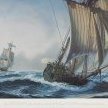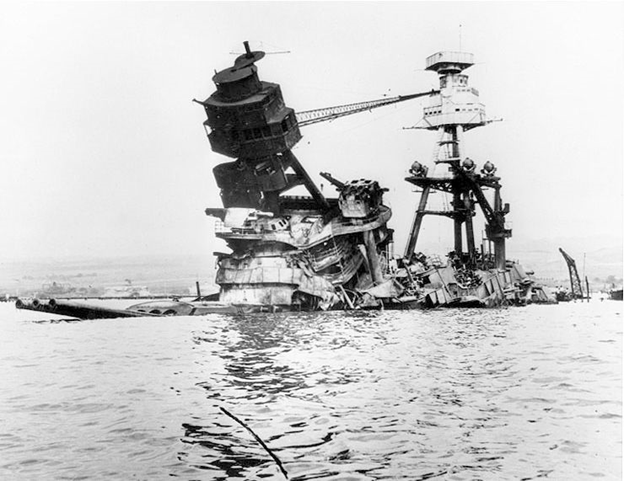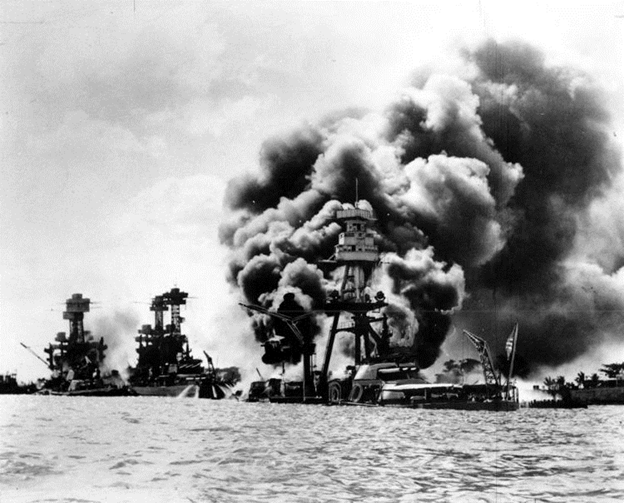-
Posts
5,885 -
Joined
-
Last visited
Content Type
Profiles
Forums
Gallery
Events
Everything posted by lmagna
-
I hope the size of plates on the Victory are in line with the much smaller Bounty. 1220 X 256 cm seems pretty large. I linked the Constitution because #1 I knew there was information on the size of her plates with pictures of people holding plates, and #2 plenty of pictures. I wanted to do the same with the CW Morgan as she has also gone through a restoration recently but even though I can find some mention that she is also coppered the pictures do not seem to support this.It seems that she has been painted with anti fouling paint only. I don't know if any of the replica ships around have copper bottoms. I was able to find this in regards to the Constitution's 1927-1931 refit: Ship has been copper sheathed from keel to 23’ 6” aft and to a height of 21’ 0” forward – 3,400 sheets of copper, 14”x 48”, in various weights; 28-oz. between keel and shoe, 26-oz. at turn of bilge and at water line; remainder 22-oz., all of which is secured to wood planking by 1 1/8” and 1 ¼” copper sheathing nails. Approximately 12.5 tons of sheathing copper, 1600 pounds [copper] sheathing nails, 38.4 tons new copper fastening used; 4 tons old copper fastening [reused?], 8 tons old copper left in ship; a total of 63.7 tons of copper now in the ship. [Commandant, U.S. Navy Yard, Boston, “U.S. Frigate CONSTITUTION (IX21) – Research Memorandum”, 1931, 60.]
-
I am feeling a little out of my comfort zone offering any advice on this as like many things in wooden ship building I have no personal experence with coppering a ships hull. The only ships I have ever built with copper bottoms were the Revell Constitution and Charles W. Morgan, both in plastic and both as a teen sometime back when Plesiosaurs were swimming in the sea. but luckily there are others that have written on the subject! One of them are here: http://modelshipworldforum.com/ship-model-framing-and-planking-articles.php As for the size of the plates, this may give you some insight: https://ussconstitutionmuseum.org/2016/11/18/new-copper-sheathing-2/ Hope that gives you some help.
-
I don't know if sanding and sealing or locating and cutting out the various deck openings is next, but you might consider making the openings in the deck before installing the bulwarks just for ease of handling. I think I would be more inclined to go with the copper strips below the waterline not only fo rthe looks but if the research says that she had a copper bottom at the time you are depicting then you are stuck with it! I think you would find that copper colored paint would not look all that good on this model anyway. Just an opinion, worth what you paid for it.
-
I wish I could get the chance to try! I think it would be my lower back that would suffer though. I am not sure what you are saying about your planking. Looks good from here! It will look even better when you are done, install the deck openings, do a little sanding, and add the bulwarks and deck furniture. Shipyard construction always looks messy!
-
Hi Bill It's not a Revenue Cutter, but have you considered the Swift Virginia Pilot Boat 1805 1:50 Scale Artesania Latina Kit? It is a big scale yet small ship. Should fit into an apartment, and can be built with only hand tools. No need for big shop tools.
-
They are bigger than I thought they would be! About 3/8" wingspan maybe a little more. Are they supposed to be Hellcats?
- 12 replies
-
- enterprise
- revell
-
(and 1 more)
Tagged with:
-
According to "USS Arizona (BB 39)Ships data: A photographic History By Norman Friedman, the Arizona was upgraded to the Kingfisher aircraft in her last overhaul at Puget Sound late in 1940. On her return to Pearl Harbor in July of 1941 "She was equipped with her final spotter complement of three OS2U-2 Kingfisher monoplanes." As can be seen in the above pictures these planes were not on board at the time of the attack on December 7th.
-
I don't think so Mark. With the exception of modern day helicopters I think it has been the practice to fly off the aircraft before entering port and recover them after leaving, if a shore location is available. As you said maintenance is MUCH easier on shore than on board. Plus in most cases fixed wing aircraft can't be launched from a stationary ship, even though in this case they could have lowered the planes overboard with the cranes and then flew them off from the water. Much easier to just catapult off while still underway.
-
That may well be the case according to these pictures I can not see any evidence of planes on either catapult.
-
That couple of mm would raise it about the same as it would have been above the original plastic deck before you added the wood. The same would apply to the other deck openings. It would seem that they all should have at least a short combing around them to at least make an edge that could hold a canvas cover in foul weather and stop some of the water from flooding the below decks.
-
They did replace the Gulls with the Curtiss Seamew, but that plane turned out to be an under powered piece of junk. So for the first time in history they pulled a plane out of second line operations and returned the Seagulls to front line operations while speeding up the development of the Kingfisher. Look again at the picture I showed you about the Arizona catapults. It is clear that in August 1940, only 16 months before Pearl Harbor she still had Seagulls. The first six Kingfishers were also delivered, probably to the battleships first, in that same month. It was then a matter of how many and how fast the remaining planes were replaced, and to what ships in the pecking order. Newest to oldest, place in the battle line, or random. All I know at this point from the research that I have been doing on the Houston was that none of the cruisers had been updated by 1941, some of them never were, and the Seagulls served on until 1945 even though no new aircraft were made. If it ends up that you want to convert back to biplane I could send you a couple of !/350th Seagulls and possibly use them?
-
I am curious to see the aircraft on the deck! They must be smaller than ants!
- 12 replies
-
- enterprise
- revell
-
(and 1 more)
Tagged with:
-
Great work OC. Nice to see you moving along so well. Dumb question I suppose but shouldn't the combings around hatches and stuff on the deck be raised by the same amount as the thickness of your planks? They look a little odd to me being flush with the deck.
-
I hate to say it but it may be possible that the Arizona on Dec 7 still had Seagulls attached to her. The first 54 Kingfishers were delivered to the U.S. Navy beginning in August 1940 and six had been assigned to the Pearl Harbor-based Battle Force before the end of the same year. Many of the following 158 OS2U-2s were attached to flight training at Naval Air Station Pensacola, Florida, but 53 were assigned to equip the newly established Inshore Patrol Squadrons, based at NAS Jacksonville, Florida. I have a book coming on the Arizona, "USS Arizona (BB 39) Ship's Data: A Photographic History, Norman Friedman," It should be here on Tuesday I'll take a look if you are interested.
-
One of these days I am going to learn to look first and then THINK about opening my mouth! I wrote about the ceiling and overhead and felt like I really knew what I was talking about. STUPID ME! The brain became engaged later, AFTER I had spouted all my stuff and I decided it look it up, after all this is the internet age where any answer is just a few keystrokes away, right? So here is what I came up with in just a few seconds: Ceiling: The lining or inboard sheathing covering the frames of a wooden boat. Usually ceiling is light planking or slats covering the frames in cabin areas to provide insulation, deaden sound, reduce condensation and provide a more finished appearance. (Lubbers beware: the ceiling is located along the inboard sides of a ship, never overhead.) Sorry to the people who read my first post and wondered who this fool was. I will be deleting that part of the post to avoid further possible confusion and personal embarrassment.
- 49 replies
-
- constitution
- revell
-
(and 1 more)
Tagged with:
-
I suppose you just had them laying around from the last time you needed to cuff one of your prisoners!
- 209 replies
-
- constitution
- revell
-
(and 1 more)
Tagged with:
-
I think that much of the time the boat would be in the water when the crew needed access to the hatches. It would probably be put over the side as soon as the anchor went down, and in many cases would be towed behind on shorter inland river and coastal passages. As always your work and steady progress is impressive.
- 360 replies
-
- sultana
- model shipways
-
(and 1 more)
Tagged with:
-
Whatever you want to call it, your work is looking nice so who cares! I painted the Captain's quarters when I built this kit as a teen. I can't remember what all the pictures were but I do remember that one was a world map. I painted them all, along with the diamond pattern on the deck. But after you put the transom and decks into place it is a little hard to see your work. The same applies to the forward and sternward cannon on the gun deck. After you place the spar deck into place you can no longer even see all of the rigging no matter how hard you try. You might try going down to your local drug store and taking a look at their reading glasses they normally have glasses that range from 1.5 to 3,0X. You can try out what you want and even pick several pairs to suit the different needs in your build. They are normally fairly inexpensive and certainly lighter than the headsets you linked to. If you do pick the headset you at least picked the glass lenses. The ones with the plastic lenses are in my opinion, (For what it's worth) pure junk.
- 49 replies
-
- constitution
- revell
-
(and 1 more)
Tagged with:
-
Hello Rich Welcome to the madhouse, (At least my corner of it). What are the odds!!!!!!!!!! I have that same kit. While I have my doubts that it has much resemblance to the actual Cabot, no one can really tell what she looked like, it should be able to make up into a pretty nice model of a Continental Brigantine. If I could be so bold I would suggest looking into Chuck's practicum on building the Sultana. They are very similar models and this kit could benifit from the same modifications. Chuck Passaro's practicum Looking forward to seeing how it goes.
-
That is supposed to be a pretty good book. I don't own a copy myself. You will want to be careful though if you learn too much you will begin feeling the need to redo the white stripe along the sides in yellow and change to number of windows on the stern and other going down the rabbit hole stuff! You need to remember that the ship is over 200 years old and that there have been a lot of changes in those years. Some better documented than others, but changes none the less. As for the history, there are so many books written by so many people over the years that I would be at a loss to say what one was my favorite. The one I remember the most and enjoyed was written in 1934 when the Constitution was going from port-to-port around the US and even includes some of the more major events of that cruise.
- 209 replies
-
- constitution
- revell
-
(and 1 more)
Tagged with:
-
I think that is why they used white below decks. It is possible that they used whitewash back in the day rather than paint but either way it made the mostly closed up lower deck spaces lighter and less gloomy day and night. That is certainly the case on-board the Constitution today. Don't worry about terms Mike call them walls with shuttered windows if you want. You are building a model for enjoyment and personal satisfaction, not trying to pass a seaman's exam! By the time you are done you will be surprised how many otherwise useless nautical terms you will know. I personally think that is one of the shortcomings of the modern multi language requirements in models. "Back in the day" they used to actually name the parts you were installing in the construction booklet. Now days they just give it a number. For the most part you don't need to translate numbers, but you also miss out on the learning part that used to be so much the part of building plastic kits. I still have many of my old plans for plastic models, dating back probably 30+ years and without exception they are FAR more instructive than plans I see on new models.
- 209 replies
-
- constitution
- revell
-
(and 1 more)
Tagged with:
-
While the inner bulwarks on the spar deck are green, they would be white in the lower deck space between the gun deck and the spar deck. I think Jim is right though in that it would be MUCH easier to paint them without fear of messing up the decks if you paint them prior to installing the decks. That would require removing the gun deck as well so it would be best to not glue it until after you do the painting.
- 209 replies
-
- constitution
- revell
-
(and 1 more)
Tagged with:
About us
Modelshipworld - Advancing Ship Modeling through Research
SSL Secured
Your security is important for us so this Website is SSL-Secured
NRG Mailing Address
Nautical Research Guild
237 South Lincoln Street
Westmont IL, 60559-1917
Model Ship World ® and the MSW logo are Registered Trademarks, and belong to the Nautical Research Guild (United States Patent and Trademark Office: No. 6,929,264 & No. 6,929,274, registered Dec. 20, 2022)
Helpful Links
About the NRG
If you enjoy building ship models that are historically accurate as well as beautiful, then The Nautical Research Guild (NRG) is just right for you.
The Guild is a non-profit educational organization whose mission is to “Advance Ship Modeling Through Research”. We provide support to our members in their efforts to raise the quality of their model ships.
The Nautical Research Guild has published our world-renowned quarterly magazine, The Nautical Research Journal, since 1955. The pages of the Journal are full of articles by accomplished ship modelers who show you how they create those exquisite details on their models, and by maritime historians who show you the correct details to build. The Journal is available in both print and digital editions. Go to the NRG web site (www.thenrg.org) to download a complimentary digital copy of the Journal. The NRG also publishes plan sets, books and compilations of back issues of the Journal and the former Ships in Scale and Model Ship Builder magazines.





